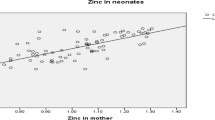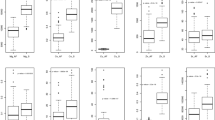Abstract
A study of iron, zinc, copper and selenium concentration levels was carried out in three compartments namely, maternal serum (MS), colostrums and cord blood serum (CS) of healthy Indian mothers (n = 42) who delivered healthy normal neonates without any congenital anomalies at Bhabha Atomic Research Centre hospital, Mumbai. Fe, Zn, Cu in maternal serum, cord blood and colostrums were estimated by flame atomic absorption spectrometry while Se was determined by graphite furnace absorption spectrometry. It was seen that there was a significant difference in the level of trace elements in the three compartments. The average levels of Fe in the three compartments were 1,132 ± 519, 2,312 ± 789 and 1,183 ± 602 μg/L while Zn was 514 ± 149, 819 ± 224 and 7,148 ± 2,316 μg/L respectively. Mean Cu values were 1,614 ± 295, 301 ± 77 and 392 ± 174 μg/L respectively while Se values were 70 ± 15, 36 ± 10 and 23 ± 8 μg/L respectively. The results indicated a positive correlation of Fe and Zn concentrations in MS versus CS which were (r = 0.386), (r = 0.572) respectively and Fe levels in MS and colostrums (r = 0.235). A few inter element correlations were found within compartments. Zn and Se showed a negative correlation in both MS (r = −0.489) and colostrums (r = −0.258) while a positive inter correlation of Fe and Zn was seen in MS (r = 0.44) and in CS (r = 0.54). This study gave us an overview of the serum and colostrum values of mother and neonates in Indian population, data of which are scarce.


Similar content being viewed by others
References
Prohaska JR. Functions of trace elements in brain metabolism. Physiol Rev. 1989;67:858–901.
Bothwell TH. Iron requirements in pregnancy and strategies to meet them. Am J Clin Nutr. 2000;72(Suppl):257S–64S.
Bothwell TH, Charlton RW, Cook JD, Finch CA. Iron metabolism in man. London: Blackwell; 1979.
Viteri FE, Allen L, King J, Lonnerdahl B. The consequences of iron deficiency and anemia in pregnancy. New York: Plenum Press; 1994.
Iqbal ASM, Shahidullah Md, Md Islam N, Akhter S, Banu S. Serum zinc and copper levels in the maternal blood and cord blood of neonates. Indian J Pediatr. 2001;68:523–6.
Hurley LS, Swenerton H. Congenital malformations resulting from zinc deficiency in rats. Proc Soc Exp Biol Med. 1966;123:692–7.
Ortega RM, Quintas ME, Andre's P, et al. Zinc status of a group of pregnant Spanish women: effects on anthropometric data and Apgar score of neonates. Nutr Res. 1999;19:1423–7.
Huddle JM, Gibson RS, Cullinan TR. Is zinc a limiting nutrient in the diets of rural pregnant Malawian women? Br J Nutr. 1998;79:257–9.
Al-Bader A, Hussain T, Al-Mosawi Otaibi M, Abdul H, Khalifa D, et al. Serum zinc and copper concentrations in pregnant women from Kuwait. J Trace Elem Exp Med. 1997;10:5–209.
Puig S, Thiele DJ. Molecular mechanisms of copper uptake and distribution. Curr Opin Chem Biol. 2002;6:171–80.
Arthur JR, Beckett GJ. Symposium 2: newer aspects of micronutrients in at risk groups, new metabolic roles for selenium. Proc Nutr Soc. 1994;53:615–24.
Kohrle J, Brigelius-Flohe R, Bock A, Gartner R, Meyer O, Flohe L. Selenium in biology: facts and medical perspectives. Biol Chem. 2000;381:849–64.
Kumar A, Rai AK, Basu S, Dash D, Singh JS. Cord blood and breast milk iron status in maternal anemia. Pediatrics. 2008;121:e673–7.
Awadallah SM, Abu-Elteen KH, Elkarmi AZ, Qaraein SH, Salem NM, Mubarak MS. Maternal and cord blood serum levels of zinc, copper, and iron in healthy pregnant Jordanian women. J Trace Elem Exp Med. 2004;17:1–8.
Upadhyaya C, Ajmera P, Sharma P. Serum iron, copper and zinc status in maternal and cord blood. Indian J Clin Biochem. 2004;19(2):48–52.
Ozkan TB, Durmaz N, Erdemir G, Ilcol YO. Trace element concentrations in breast milk and sera: relations with lactation. J Biol Environ Sci. 2007;1(3):143–7.
Almeida A, Lopes CMP, Silva A, Barrado E. Trace elements in human milk: correlation with blood levels, inter-element correlations and changes in concentration during the first month of lactation. J Trace Elem Med Biol. 2008;22:196–205.
Alvarez SI, Castanon SG, Calvo Ruata ML, et al. Updating normal levels of copper, zinc and selenium in pregnant women. J Trace Elem Med Biol. 2007;21 S1:49–52.
Krachler M, Rossipal E, Micetic-Turk D. Trace element transfer from the mother to the newborn-investigations on triplets of colostrum, maternal and umbilical cord sera. Eur J Clin Nutr. 1999;53:486–94.
Perveen SAW, Vohra N, Bautista LM, Harper R. Effect of gestational age on cord blood plasma copper, zinc, magnesium and albumin. Early Human Dev. 2002;69:15–23.
Vir SC, Love AGG, Thompson W. Zinc concentrations in hair and serum of pregnant women in Belfast. Am J Clin Nutr. 1981;34:2800–7.
Aggett PJ, Harris JT. Current status of zinc in health and disease states. Arch Dis Child. 1979;54:909–17.
SE Minoia C, Apostoli P, Pietra R, Pozzoli L, Gallorini M, Nicolaou G, Allessio L, Capodaglio E. Trace element reference values in tissues from inhabitants of the European community. Sci Total Environ. 1990;95:89–105.
Caroli SAA, Coni E, Petrucci F, Senofonte O, Violante N. The assessment of reference values for elements in human biological tissues and fluids: a systematic review. Crit Rev Anal Chem. 1994;24:363–98.
Schulpis KH, Karakonstantakis T, Gavrili S, Chronopoulou G, Karikas GA, Vlachos G, Papassotiriou I. Maternal-neonatal serum selenium and copper levels in Greeks and Albanians. Eur J Clin Nutr. 2004;58:1314–8.
Micetic-Turk D, Rossipal E, Krachler M, Li F. Maternal selenium status in Slovenia and its impact on the selenium concentration of umbilical cord serum and colostrum. Eur J Clin Nutr. 2000;54:522–4.
Raghunath R, Tripathi RM, Mahapatra S, Sadasivan S. Selenium levels in biological matrices in adult population of Mumbai. Indian J Sci Total Environ. 2002;285:21–7.
Alimonti A, Petrucci F, Laurenti F, Papoff P, Caroli S. Reference values for selected trace elements in serum of term newborns from the urban area of Rome. Clin Chim Acta. 2000;292:163–73.
O’ Leary JANG, Vosburgh GJ. Maternal serum copper concentrations in normal and abnormal gestations. Obstet Gynecol. 1966;28:112–6.
Food and Nutrition Board NRC. Recommended dietary allowances. 10th ed. Washington, DC: National Academy of Sciences; 1989.
Krachler M, Li FS, Rossipal E, Irgolic KJ. Changes of the concentrations of trace elements in human milk during lactation. J Trace Elem Med Biol. 1998;12:159–76.
Rossipal E, Krachler M. Pattern of trace elements in human milk during the course of lactation. Nutr Res. 1998;18(1):11–24.
Benemariya H, Robberecht H, Deelstra H. Copper, zinc and selenium concentrations in milk from middle-class women in Burundi (Africa) throughout the first 10 months of lactation. Sci Total Environ. 1995;164:161–74.
Author information
Authors and Affiliations
Corresponding author
Rights and permissions
About this article
Cite this article
Jariwala, M., Suvarna, S., Kiran Kumar, G. et al. Study of the Concentration of Trace Elements Fe, Zn, Cu, Se and Their Correlation in Maternal Serum, Cord Serum and Colostrums. Ind J Clin Biochem 29, 181–188 (2014). https://doi.org/10.1007/s12291-013-0338-8
Received:
Accepted:
Published:
Issue Date:
DOI: https://doi.org/10.1007/s12291-013-0338-8




